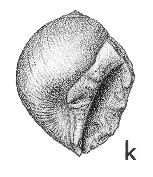
Revised descriptions of New Zealand Cenozoic Mollusca from Beu and Maxwell (1990)

 | Revised descriptions of New Zealand Cenozoic Mollusca from Beu and Maxwell (1990) | 
|
  (Pl. 29k): holotype, GS1148, R19/f8009, Mangare Road, upper Waitara Valley, North Taranaki, Tongaporutuan (TM6526, GNS) |
Beu & Maxwell (1990): Chapter 13; p. 263; pl. 29 k.
Synonymy: Uber scalptus Marwick 1924d, p. 568
Classification: Naticidae: Poliniceinae
Description: Small for genus (17-20 mm high), short and oval, with low spire and large, wide, enveloping last whorl, and no anterior canal; smooth and lightly polished, except for weak growth lines and zone of short, very shallow and narrow, axial grooves below suture (curved backward to suture in conformity with strongly retracted outer lip). Aperture simple, D-shaped; inner lip with prominent wide callus, completely filling umbilicus apart from very shallow basal groove; callus of adult specimens crossed by 2 widely diverging, wide, shallow, but clearly defined grooves, one at junction of parietal and funicular calluses, the other rather low on funicle; much of callus surface irregularly grooved and granulous on many specimens; callus of juvenile specimens crossed by deep, curved central groove, shorter and wider groove above, and 2 short, weak grooves below. Left edge of callus regularly and weakly convex, or bearing one or 2 small protrusions opposite callus grooves. Aperture inclined at angle of about 25°-30° (angle varies with spire height, which is highly variable). Protoconch very low, wide, of about 2-2.5 apparently smooth whorls, not clearly distinguished from teleoconch.
Comparison: Maxwell (1988a, p. 49) pointed out that juvenile specimens of Polinices scalptus have much more prominent callus grooves than adults, and only the two most prominent grooves are retained on adults. This ontogenetic development of callus grooves distinguishes Waiauan to Tongaporutuan (and perhaps Kapitean) specimens from the older ones included in the species by earlier authors. Clifden specimens (Altonian-Clifdenian) included here by Fleming (1966b) are not conspecific, and several Miocene species appear to be unnamed. Maxwell (1988a, p. 49) pointed out that juvenile specimens of P. esdailei (Kaiatan-Runangan) and P. modestus (Duntroonian-Altonian) have far less prominent callus grooves than those of P. scalptus. Ontogenetic development of callus grooves needs checking in other species accorded long time ranges, such as P. obstructus (Pl. 37i). P. scalptus occurs sympatrically with P. obstructus at some localities, but is always easily distinguished by its smaller size, lower spire, more strongly inclined aperture, wider callus, consistently closed umbilicus, more prominent and more strongly diverging callus grooves, and its axial grooves below the suture that are absent from P. obstructus.
Distribution: Waiauan-Tongaporutuan, ?Kapitean; Mangare Road, upper Waitara Valley, North Taranaki, Tongaporutuan (type); Tongaporutuan, several localities in North Taranaki, and tributaries of Mangaopari Stream, southern Wairarapa; Waiauan, near Karoro, Greymouth, Stillwater Mudstone (Maxwell 1988a, p. 49); ? Kapitean, Te Araroa, East Cape, and Kapitea Creek and nearby localities, Westland (ontogeny not checked but adult shells appear to be conspecific).
Cite this publication as: "A.G. Beu and J.I. Raine (2009). Revised
descriptions of New Zealand Cenozoic Mollusca from Beu and Maxwell (1990). GNS
Science miscellaneous series no. 27."
© GNS Science, 2009
ISBN
978-0-478-19705-1
ISSN 1177-2441
(Included with a PDF facsimile file
copy of New Zealand Geological Survey Paleontological Bulletin 58 in CD version
from: Publications Officer, GNS Science, P.O. Box 30368 Lower Hutt, New
Zealand)